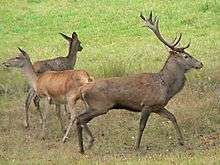Onchocerca tubingensis
Onchocerca tubingensis is the name of a nematode.[1] It was discovered in 1974 and published by O. Bain und H. Schulz-Key in Tropenmedizin und Parasitologie and named after Tübingen.[2] Red deer (Cervus elaphus) are the host of this parasite.[3] The adult worms of Onchocerca tubingensis are found in subcutaneous nodules on the caudal part of the back, while the microfilariae are distributed on the ventral part of the body with maximum densities in the region of the sternum and with lower densities on the inner sides of the hindlegs. The infection rates of 94 red deer investigated in southern Germany during 1907–1974 were 23%.[4]

Red deer are the host of Onchocerca tubingensis
| Onchocerca tubingensis | |
|---|---|
| Scientific classification | |
| Kingdom: | |
| Phylum: | |
| Class: | |
| Order: | |
| Family: | |
| Genus: | |
| Species: | O. tubingensis |
| Binomial name | |
| Onchocerca tubingensis Bain & Schulz-Key, 1974 | |
References
| Wikispecies has information related to Onchocerca tubingensis |
- The Free Dictionary
- H Schulz-Key, O Bain: A fourth species of Onchocerca, O. garmsi n.sp. from the European deer (author's transl) Archived 2012-04-06 at the Wayback Machine
- Schulz-Key, H; Bain, O (1976). "A fourth species of Onchocerca, O. Garmsi n.sp. From the European deer (author's transl)". Tropenmedizin und Parasitologie. 27 (4): 474–8. PMID 1006803.
- Schulz-Key, H (1975). "Studies on the Filariidae of Cervidae in southern Germany. 2. Filariidae of the red deer (Cervus elaphus)". Tropenmedizin und Parasitologie. 26 (3): 348–58. PMID 1189029.
This article is issued from Wikipedia. The text is licensed under Creative Commons - Attribution - Sharealike. Additional terms may apply for the media files.